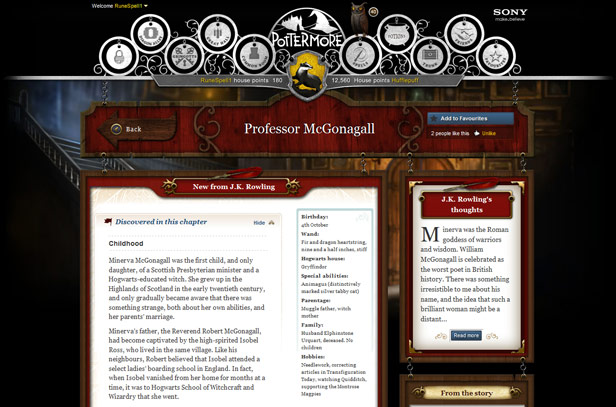A New Chapter for E-Books

The problem with the Harry Potter series, for me and many others, was that it had to end. For fans used to midnight book-launch parties and concerts by bands with names like Draco and the Malfoys, the 2007 release of author J. K. Rowling’s seventh book closed out an era. But starting this past summer on Harry Potter’s birthday—July 31—Rowling offered fans the chance to bring Harry Potter to new life by hunting the “Magical Quill” online.
Harry Potter fans are notoriously hungry for information related to the green-eyed boy wizard, but this wasn’t just a marketing stunt offering up a few scraps. The quill gave the bearer early access to the new website Pottermore, where Rowling has hired a team to create a new way to read her books. The site has exclusive rights to sell e-book editions of the Harry Potter series, but it’s also seeded with 18,000 previously unreleased words of Rowling’s Potter-related writing, with more to come. Over time, the site will weave the books together with interactive and social features that allow readers to connect with one another and with the characters in Rowling’s world.
“In making e-books available, we wanted to provide something special for readers—not just something that was a reprise of what had taken place in print form,” says Rod Henwood, interim CEO of the Pottermore company, which Rowling established to maintain the site.
Rowling’s effort points the way toward a social, deeply interconnected, digital experience of reading a book—a book that is designed to change over time. Not all authors will have the resources and readership to produce a project like Pottermore. Nonetheless, the website presages a new kind of reading experience, one that takes greater advantage of the electronic aspect of e-books.
Things Reviewed
Pottermore
www.pottermore.com
Principles of Biology
$49
Nature Education, 2012
There’s much to be dissatisfied with in today’s typical experience of e-books. They lack the sensual attributes of books—including the paper quality that signals the difference between an elegant literary edition and a cheap, pulpy paperback. But I’m not just lamenting the vanishing joys of print. As a vision for the future, today’s e-books are far too conservative—they miss many opportunities.
I’m also not advocating a return to the distracting bells and whistles that characterized the CD-ROM books of decades past, or suggesting the revival of hypertext literature. What I do want is for e-books to reflect the immediacy and responsiveness of today’s Internet. A truly electronic book should allow me, with just a few clicks, to jump through every dream sequence in a work of fiction or follow supporting lines of argument threaded through a work of nonfiction. And a book in electronic form doesn’t have to be a static snapshot. It can and should grow and change.
Rowling’s Pottermore could be such an effort. The site is organized around “moments”—key points in the Harry Potter stories. For each moment, Pottermore features a lavishly illustrated interactive scene, where users can choose to linger or not. Exploring the scene provides a chance to find new snippets of Rowling’s writing, such as expanded back stories for characters. The moments interface tracks characters, places, and objects that appear in the stories—all of them, not just the major ones—and presents information about them in one place, with pointers to the stories themselves. Users can put their favorites on their profiles, discuss them with the site’s community, or upload their own art.

Crucially, this interactivity isn’t just filigree on the Pottermore website that remains separate from the books themselves. When I read the seven books, I was taken with the Sorting Hat, a magical hat that detects deep currents in the wearer’s personality and determines which house at the wizarding school would best suit him or her. People reading a Potter e-book through Pottermore can get their own house assignments from the hat at the same time Harry gets his. The readers’ assignments affect their later interactions on Pottermore—and expose them to bonus material, written by Rowling, about their house.
No matter how impressive Pottermore ends up being, it’s still pulling a print work into an electronic format. Next year, Nature Education will release a more comprehensive attempt to rethink the electronic book, a $49 textbook called Principles of Biology. It results from the vision of Vikram Savkar, senior vice president and publishing director of Nature Publishing Group, who was responsible for launching the company’s education arm in 2007.
Students don’t buy a copy of the book—they buy lifetime access. The plan is for the textbook to serve not only as a reference for the class but as a pointer to further knowledge. Instead of publishing revised editions, Savkar’s team will keep the book up to date.
Principles of Biology is written as a series of more than 200 self-contained modules; the publisher has suggested an order for the modules, but instructors who use the book in their classes can freely drop or shuffle them. Instructors can also choose settings that increase or decrease the difficulty of the material. Principles of Biology connects related modules, and with just a click, students can access journal articles, summaries of those articles, and online resources that weren’t produced by Nature.
To make this possible, Savkar’s team shied away from creating the sort of e-book familiar to users of the Kindle or iPad. Like Pottermore, Principles of Biology is fundamentally a website, built in part with a developing technology called HTML5 that’s designed for interactivity and can appear on any device with a Web browser. (Principles also uses Flash, so it can be read in browsers that don’t yet support HTML5.) Savkar says that tying the book to the Internet itself, rather than creating specific apps or versions for specific devices, is the only way to keep the development cost down over time while ensuring that students can access the book from anywhere.
Even with that approach, none of this comes easily or cheaply. Henwood says the team that became Pottermore started working on digital experiences for Rowling’s series even before the iPad was launched, and the e-book content was recently delayed until early 2012. Nature’s process is also slow—Savkar expects that it will take his team at least a year to build its next digital textbook. The economics of publishing are such that few books will be able to get the painstaking, hand-designed development that went into Pottermore and Principles of Biology. Both have potential life spans of decades rather than weeks or months, giving their creators a financial incentive to develop their time-consuming vision.
But these teams’ ideas will eventually be copied and modified in ways that are increasingly easy for other publishers to reproduce. That will slowly define new expectations for what an electronic reading experience can be, even in less lavish works. Already, for instance, with its latest Kindles, Amazon is working toward automatically adding links and social experiences to the majority of books, doing textual analysis to come up with relevant Wikipedia articles and other supplementary material from the Internet, and providing ways for people to learn which passages most readers have found interesting. These features could eventually yield the sort of immediate document that makes an e-book truly worthy of the name.
Erica Naone is Web and Social Networking Editor at Technology Review.
Keep Reading
Most Popular
Large language models can do jaw-dropping things. But nobody knows exactly why.
And that's a problem. Figuring it out is one of the biggest scientific puzzles of our time and a crucial step towards controlling more powerful future models.
How scientists traced a mysterious covid case back to six toilets
When wastewater surveillance turns into a hunt for a single infected individual, the ethics get tricky.
The problem with plug-in hybrids? Their drivers.
Plug-in hybrids are often sold as a transition to EVs, but new data from Europe shows we’re still underestimating the emissions they produce.
Stay connected
Get the latest updates from
MIT Technology Review
Discover special offers, top stories, upcoming events, and more.